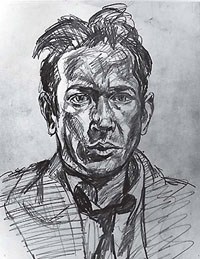EIMI

EIMI /eɪˈmiː/ is a 1933 travelogue by poet E. E. Cummings, dealing with a visit to the Soviet Union in the spring of 1931. The book is written in the form of abstract prose verse.
Background information
EIMI (Greek εἰμί - "I Am") is a 432-page volume recounting the visit of American poet Edward Estlin Cummings to Moscow, Kiev, and Odessa from May 14 to June 14, 1931.[1] Packing a portable typewriter with him, Cummings kept copious notes of his Soviet journey and wrote the book after his return to the United States.[2]
Although actually a stylized work of non-fiction, Cummings's book was originally touted as a novel by Covici-Friede, a small publisher located in New York City.[2]
In the book Cummings employs an abstract form of verse comparable to that of Ulysses by James Joyce and uses non-standard sentence structure, punctuation, spacing, and text breaks to evoke a sort of confusion and tension in the reader akin to his own feelings as a non-Russian speaker in the Soviet metropolis.
In Moscow, Cummings meets up with an acquaintance from his days at Harvard University, Henry Wadsworth Longfellow Dana, a committed Communist then living at the Metropole Hotel.[3] Dana showed Cummings around the city and acted as a mentor, attempting — unsuccessfully — to win the apolitical Cummings' sympathies to the Soviet cause before the pair split over political differences.[3] While in Moscow Cummings also met Joan London, daughter of novelist Jack London, and her husband, the newspaper correspondent Charles Malamuth.[3]
The theme of the work deals with Cummings' growing disappointment with the squalor and inefficiency he saw in the USSR, as well as the lack of intellectual and artistic freedom he observed. In it, he described the Soviet Union as an “uncircus of noncreatures.” Lenin's tomb, in which the late dictator’s preserved body is on display, especially revolted Cummings and inspired him to create the most impassioned writing in the book. In tracing the course of his 35-day trip through the Soviet Union, Cummings made frequent allusions to Dante’s Inferno and its story of a descent into Hell, equating the two journeys. For some time after the publication of Eimi, Cummings had a difficult time getting his poetry published. The overwhelmingly left-wing publishers of the time refused to accept his work. Cummings had to resort to self-publishing several volumes of his work during the later 1930s.[1][4]
Reviews

EIMI was reckoned to be "a large poem" by a "penguin-Dante" in Marianne Moore's review of the work in Poetry magazine, 1933.[5] Moore judges the book to be an "'enormous dream' about the proletarian fable" in which Cummings shifts grammatical and lyrical styles "as a seal that has been swimming right-side-up turns over and swims on its back for a time."[5]
After being out of print for nearly half a century, EIMI was reissued in 2007 by the New York publisher Liveright.[2] This brought the work to the attention of a new generation of reviewers, including Frank Bures of World Hum, who wrote:
"To call EIMI an easy read would be a lie. It’s a long, slow slog (like taking a train through the Soviet Union!) that requires tiresome mental gymnastics to understand each sentence. Much of it is impenetrable. Other parts are incomprehensible. Some parts, I have to admit, I read really, really fast.
But it’s worth a look, nonetheless, at least as a glimpse of a time and place that’s no longer with us, and a journey with one of the most unusual writers ever, and one who didn’t like the world he saw being created on his journey into the heart of Stalin’s empire. It was a world that made him, in the end, cry out in a plea for what he saw being extinguished, for the very thing that made him a poet, and for that which makes us all human..."[2]
Bures calls the book a "very political travelogue" which "sees the political landscape as integral to the place," thereby getting at "bigger questions about the kind of worlds we create and that create us."[2]
Footnotes
- ^ a b Harry W. Nerhood, To Russia and Return: An Annotated Bibliography of Travelers' English-Language Accounts of Russia from the Ninth Century to the Present. [Columbus, OH]: Ohio State University Press, 1968; pp. 218-219.
- ^ a b c d e Frank Bures, EIMI: A Journey Through Soviet Russia, World Hum, August 14, 2007. www.worldhum.com/
- ^ a b c Carla Blumenkranz, "The Enormous Poem: When E.E. Cummings Repunctuated Stalinism." Poetry Foundation. www.poetryfoundation.org/
- ^ "E. E. Cummings". Poetry Foundation. Poetry Foundation. April 19, 2018. Retrieved 20 April 2018.
{{cite web}}: CS1 maint: others (link) - ^ a b Marianne Moore, "A Penguin in Moscow: Eimi, by E. E. Cummings," Poetry, 1933.
Editions
- First edition: EIMI. New York: Covici-Friede, 1933. —First printing was 1381 copies signed and numbered.
- Second edition: EIMI: The Journal of a Trip to Russia. New York: William Sloan Associates, n.d. [1949] —Facsimile typography of first edition; cover title.
- Third edition: EIMI. New York: Grove Press, n.d. [1958].
- Fourth edition: EIMI: A Journey Through Soviet Russia. New York: Liveright, 2007.
Further reading
- Norman Friedman, "Eimi (1933)," E.E. Cummings: The Growth of a Writer. Carbondale: Southern Illinois University Press, 1964; pp. 109-124.
- Richard S. Kennedy, "Anne and Russia" and "The Unworld Visited," in Dreams in the Mirror: A Biography of E.E. Cummings. New York: Liveright, 1980; pp. 304–315, 327-335.
